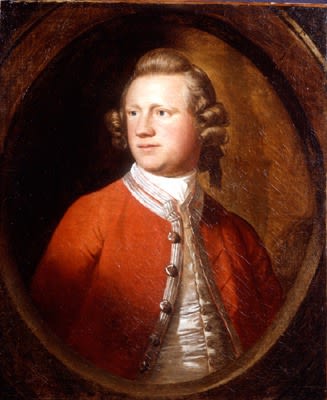
Sir Joshua Reynolds P.R.A.
To view all current artworks for sale visit philipmould.com
This portrait of a cheerful gentleman in a red coat is one of the more animated and more freely painted examples of Reynolds’s work during an important transitional period of his career. This portrait, and other comparable contemporary examples, such as the Portrait of Robert Haswell (Walsall Museum and Art Gallery) show that at this date Reynolds was striking out in his own direction, away from the formulaic manner of his master Thomas Hudson, and exploring a more realistic, individual and characterful representation. The differences between this portrait, and the blander examples that Hudson and his followers were painting at this date is striking, and the degree to which Reynolds wished to escape their wooden formula is apparent even in such elements as his use of the framing feigned oval. This conventional device had been used in British portraiture at least as early as the decades either side of 1600, and allowed a sense of depth and recession as though the subject were being viewed through a window. Hudson and his followers applied the oval as a flat framing element, whose only purpose was to soften the rectangle of the canvas. Reynolds employed it fitfully in 1740s but is generally content to let the sitter’s space remain identical with that of that canvas. When he does use a feigned oval as here, he seems interested in its substance as a structure, applying depth and perspective to its elements, but the means by which Reynolds does this is more painterly than pure geometry. The free curves of the framing oval enliven the background and, tightening our focus on the sitter, permit a new psychological intensity.
The novelty of Reynolds’s portraiture at this date, set against his former master Hudson and the mass of his contemporaries, lies in this greater emphasis on the study of character and psychology in his subjects – the very qualities that we now regard as inseparable from the purpose of portraiture. The lighting in this painting is also manipulated to the same ends, and the dramatic chiaroscuro is groundbreaking for British portraiture at this date, in which subjects were generally suffused in the bright, porcelain light of the rococo. The strong light falling on the sitter’s face from the left, and the free, vigorous brushwork, create a feeling of movement, the sense that the gentleman has just turned abruptly to face that side, and a sense of character and purpose – the feeling that not only has the sitter just determined to speak but that what he might say is worth hearing.
The man’s identity is not yet known. In the years after Reynolds left Hudson’s studio in 1743 – his apprenticeship cut short after only three years due to a disagreement with his master – the young painter divided his practice between London and his native Devon, working from an address in Plymouth, where he enjoyed a good practice from this date with naval officers and their families. This gentleman may, therefore, have been one of the painter’s old connections from Devon, or perhaps one of the first of the legion of patrons who were to pass through his studio in London. The freer painting of this portrait places it towards the very end of Reynolds’s first English period, the years before he left for the Continent in 1749, and perhaps the gentleman sat to Reynolds at the new studio he took on in St Martin’s Lane, the most fashionable address at the time for a society portrait painter. Already by this date the public had awoken to the quite exceptional talent that Reynolds exhibited, and in 1748 the November edition of the Universal Magazine listed him among fifty-seven ‘Painters of our own nation now living, many of whom have distinguished themselves by their performances, and who are justly deemed eminent masters’1. He was the youngest painter named, with the exception of Thomas Gainsborough, the rival with whom he would be linked for most of is life and into posterity.
1. Martin Postle, ‘Reynolds, Sir Joshua (1723-1792)’, Oxford Dictionary of National Biography, Oxford University Press, 2004.
Provenance
Irish Private Collection
Be the first to hear about our available artworks
* denotes required fields
We will process the personal data you have supplied in accordance with our privacy policy (available on request). You can unsubscribe or change your preferences at any time by clicking the link in our emails.